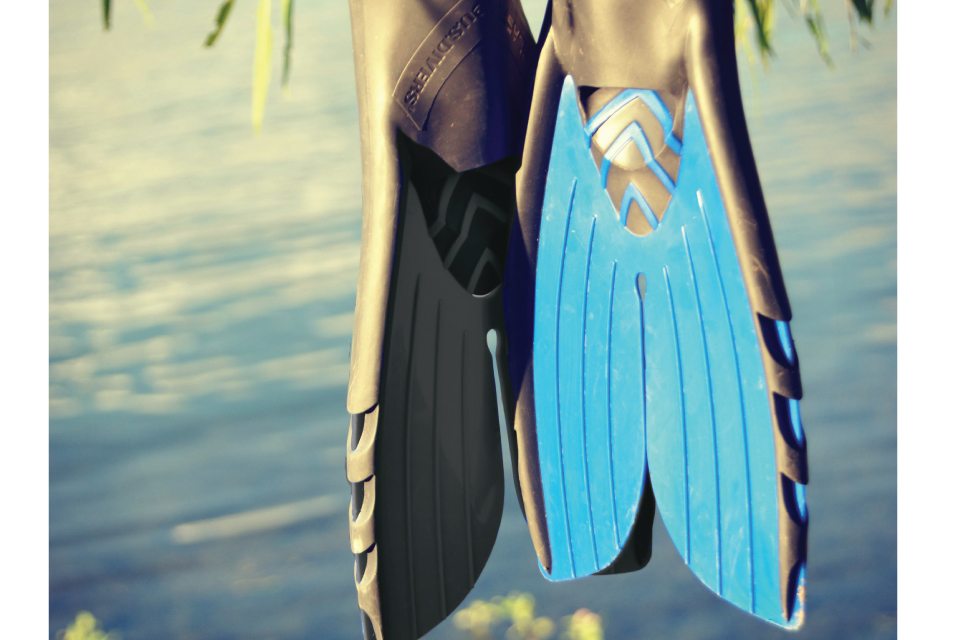Swimming with Colored Feet

Mine are black and blue. Actually, one of mine is black and the other is blue. No, they're not broken, though the black one has a crack and won't last much longer. These are the ones who have survived when their partners wore out. I've paired up the widows with each other. I get funny looks and the obvious questions, but they work okay. And, it saves me from having to shop for another pair. I hate shopping.
My favorite fins were a pair of blue Oceanways. I had them for years. They fit me perfectly. They were seemingly indestructible. Unfortunately, about a decade ago, someone stole them from the deck at the end of my lane while I was swimming at Deep Eddy. I haven't been able to find another pair that fit me so well or lasted as long. What a bummer! (By the way, if anyone out there has them, please drop them off at my place or leave them for me at Deep Eddy. No questions asked.)
When I first started using fins in the '70s, the only times I saw anyone else using them were in some swim teams' practices. Not that there were many people swimming laps at Deep Eddy, Barton Springs, Big Stacey, Northwest, Garrison, or other local pools, but the ones that were didn't have fins. Over the years, increasingly more fitness swimmers are using fins; some of them are doing all of their swimming with colored feet.
If used judiciously, fins can be great training aids. On the other hand, used otherwise, they can undermine (or should I say “de-feet”) your training. (Or, then again, maybe I shouldn't say “de-feet.”)
We use fins fairly often in TeamTexas Masters practices. And, I use them in my own training. I like to use fins:
TO OVERLOAD THE LEGS
Fins increase the amount of water displaced by your feet, increasing the stress put on the muscles in your legs. Swimming with fins is somewhat like doing reps with heavier weights. Adapting to this stress develops power and stamina.
FOR OVERSPEED TRAINING
If you've ever used fins, you know you can swim faster with them. Think of swimming with fins as similar to drafting behind a truck, being pulled by stretch cords, or riding a wave—only you have to do the work. There's something about going faster than you've ever gone that helps you swim faster than you've yet gone. Even though it's not the same, your body learns how to grab the water and how to ride it more efficiently and more effectively at greater speeds.
TO INCREASE FLEXIBILITY
Fins are widest at the point farthest from your ankles. As such, swimming with fins is a form of assisted stretching. As you get older, and especially if you run or bike, it's likely your swimming will benefit from stretching your toes away from your shins. If you can't point your feet, you are putting on the brakes when you swim. Of course, some of you know that. You may even go backwards when just kicking.
TO GET YOUR HEART RATE UP
Sprinting with fins is guaranteed to get you gasping for air and pumping blood to feed your muscles faster than Takeru Kobayashi or Joey Chestnut can gulp down a Nathan's hot dog. It's the quickest way I know to get my heart rate up (well, other than looking at Sandy, that is).
TO GET THE FEEL FOR DPS
No, I'm not referring to the Department of Public Safety. It's distance per stroke that's at issue.
TO BUILD CONFIDENCE
Confidence often comes with having done the thing before. One day, I was coaching Sandy Neilson; she was initiating her first comeback bid 12 years after winning the 100m freestyle event in the 1972 Olympics. Toward the end of practice, Sandy looked up at me and said, “I don't see any way I can go a :58.” She had been back in semi-serious training for a short time and was about a week out from her only shot at making the 100m freestyle qualifying standards for 1984 USS National Long Course Championships. The cuts were 58.59, the exact same time with which she had won the Olympics 12 years before. “Tell you what,” I said. “Put your fins on and go a pretty fast 100. It doesn't have to be all out. Just go a under a minute. You can do that with fins.” She put her fins on, pushed off the wall and went a :58 100m free. Yes, from a push. Then, about a week and a half later, at her only chance to make cuts, she swam a :58.3 and qualified for Nationals.
FOR STROKE DRILLS
I don't think you want to do all of your drills with fins on, but I think many swimmers are too sloppy when doing drills. Doing drills correctly is paramount. Fins keep you up in the water, thereby allowing you to slow down and get the drills right, especially when first learning them.
TO EVEN THE PLAYING FIELD
Throwing fins on the slower swimmers allows me to send the entire group off together on the same interval. It's fun for the slower swimmers. It increases the challenge for all. And it better enables me to watch everyone at once.
FOR A CHANGE OF PACE (Get it?)
Most people enjoy mixing it up, playing swimming with different toys, and varying the feel. I'm for it as long as we keep it purposeful. Fins add variety, if not spice, to your routine.
TO TAKE PRESSURE OFF OF THE SHOULDERS
If your shoulders are aching or sore, fins can help take the pressure off of your shoulders. They're a poor substitute, however, for taking care of injuries that might warrant medical attention.
On the other hand (or, should I say “on your feet”?) swimming or kicking easy with fins can
DE-FEET YOUR PURPOSE. (There I go again.)
Unless you are lifting weights, swimming is probably one of the only things that you do in which you rely heavily on your upper body. Throw fins on and you diminish that benefit.
That's not to say that it isn't ever okay to wear colored feet when your gas pedal is set on cruise control. But I wouldn't count that as adding much to your fitness routine or to race preparation.
Unfortunately, I see a lot of people cruising along with fins on, not getting much value from them. Many of them never swim or kick without fins.
I do see a couple of people who only swim with fins, but they stay after it pretty well. They, however, are the exceptions. Nevertheless, they likely miss the benefits of relying on the upper body. I wouldn't recommend it. Moreover, I wonder how they would fare with naked feet. And, I wonder what color are their feet.
Keith Bell, Ph.D.
A former University of Texas Head Swimming Coach and United States Masters Coach of the year, Dr. Bell currently coaches TeamTexas Masters, is the President of the American Swimming Association, LLC, and is a Sports Performance Consultant. As an author, he has written ten books and more than 70 articles. As a swimmer, Dr. Bell is a four-time Collegiate All American, has 36 World and 99 Masters National Records, and over the years has won gold medals in two World and in 67 Masters National Championships.






